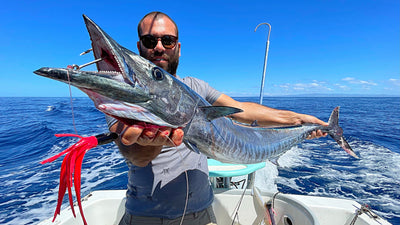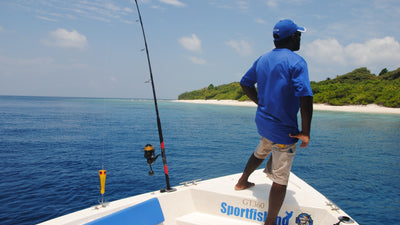Now, there is no point in beating around the bush, with the tropicalization of our sea, a “tropicalization” of the fisherman is also arriving, who is changing his way of fishing, his language, his approach to prey. If we talk about large dolphinfish, then, the fishing day immediately takes on a “Latin” flavor… especially if you then adopt “oceanic” precautions and tricks.
 (In photo dolphin fish captured with Jet Flash )
(In photo dolphin fish captured with Jet Flash )
Over the last few years, encounters with large specimens of dolphinfish have increased significantly, whereas previously they were rather sporadic. And, also thanks to the increase in fishermen who dedicate themselves to deep-sea trolling, catches with this technique have increased, to the detriment of drifting which occasionally attracted in its wake some noteworthy specimen.
International predator
We are talking about a fish that is widespread practically all over the globe. A voracious predator since birth, it spends the first stages of its life mainly in large schools, eating anything that comes into its reach and growing very quickly (we are talking about 1/1.5 kg per month), while as an adult it moves mainly in pairs or in very small schools of three or four specimens. While in the juvenile phase its voracity is also coupled with an almost total lack of suspicion, as its size increases, it also becomes more distrustful, despite maintaining its aggressiveness of a ruthless predator. This means that its capture can become anything but easy, unless you find yourself in the presence of fish in particular frenzy or activity. Staying on the "tropical" theme, where drifting and live bait trolling are little or not at all practiced, in this article we want to try to focus on the ocean technique par excellence: deep-sea trolling, aimed at catching dolphinfish.

Equipment
Even though we are talking about fish that can reach significant dimensions in some parts of the world, in our seas the average size is between 5 and 20 kg... a size that does not require the use of very heavy equipment, also to give ample space to fun, made up of fights characterized by acrobatic jumps, sudden changes of direction and fast escapes afloat. We could therefore easily orient ourselves on combos of 12, maximum 20 pounds, preferably spooled with braid, for obvious issues of reel capacity, but adopting the usual healthy precaution of inserting a nylon preterminal of at least 50 m, which allows a certain elasticity. The shock leader can be composed of about 2 m of a good 0.80 nylon, to avoid the risk of breakage upon contact with sharp fins or teeth. If necessary, in the event of a lack of specific equipment, for these fish you could also think of adapting rods and reels intended for another purpose, such as jigging or live bait trolling.

(In the hole a Jet Monkey in its most famous coloration used with ballyhoo)
Baits and baits
The main bait of the deep sea is and will always be the kona! And even the dolphin fish are crazy about it... I would therefore discard the use of various minnows, even if they could sometimes help us make some catches, but limiting us in the setup and speed of trolling. I would instead give ample space to the rigid-headed kona, especially the jet models, which have shapes and holes that cause long trails of foam, very attractive towards our friends. Even the bullets are effective, especially in very calm sea conditions and in the absence of wind. The ideal size ranges from 14 to 22 cm, and as for colors, combinations of red and white are deadly, or skirts with glitter or iridescent reflections on dark colors such as purple/black. The position of the hook should preferably be in the center of the body of the bait, better if with a rigid rig . In some cases, it may happen that the large dolphinfish quickly enter the wake from the side, giving a show with their fins out of the water, but leaving us with a bitter taste in our mouth, simply touching our bait, without eating it. To overcome this problem, in the ocean it is usual to rig the kona with the addition of natural bait, most of the time dead ballyhoo, tied specifically on the hook. In Italy we do not have this fantastic bait both for attractiveness and for fishing duration (a baited ballyhoo can last even 8 hours of trolling without wearing out), and therefore this trick of stuffing the kona is less used. If necessary, however, the sea pike, or aluzzo, or large garfish can be adapted to the purpose, taking care to check at least every hour and a half, to evaluate their condition, and replace them if necessary.

Another tip, if you use natural bait, is to fish with the clutch at the limit of slippage, in case of fish in the wake, eliminate the buzzer and open the clutch completely giving free line, controlling the exit with the thumb on the spool. When the fish eats the bait, and we will notice it from the speed with which the line comes out, we will give it time to swallow it well, and then close the clutch.
Setups and recalls
The first premise to make when talking about setups is that the divergents on board are absolutely essential to allow some baits to work outside the foam of the wake, just as the central divergent, or shot gun, is equally essential to be able to extend the long central rod without the risk that it may interfere with the other lines. The ideal setup that we can use to dedicate ourselves to dolphinfish requires no more than six rods, and any teasers or decoys. For example, starting from the longest central rod between 80 and 100 meters away from the stern, we will move on to the two outermost rods on the divergents at about 50/60 meters. The other two internal lines of the divergents at about 40 meters, and a final central one at about 20 meters. Alternatively, we could extend the two short lines on the divergents, armed only with two large teasers, in order to attract more fish in the wake. In the latter case, a rod on board armed with a dead bait and circle hook, ready to be cast when needed, could make the difference in the case of particularly lazy fish.

Essential accessories
Dolphin fish are very combative, and do not give up easily, performing jumps until the last moments. In order to avoid last-second unhooking, in the event that you decide not to release, a long gaff, strictly one piece and not telescopic, will be absolutely essential. Once hoisted on board, however, they will continue to struggle in a particularly lively manner, and for this reason a fisherman will be able to avert any dangers, and put an end to the useless suffering of the fish. A large igloo or a fish tank in which to place the dolphin fish directly after having hoisted it from the sea, will help keep the boat clean. Among the essential accessories, I think it is right, more than in any other case, to mention a smartphone or a camera to immortalize as quickly as possible the fantastic colors of this fish, before they vanish completely, leaving room for a gray that does not do justice to its beauty.

Bull Golden
You may have noticed, in some photos or in person, the peculiarity of some dolphin fish whose head has a flattened shape, or rather vertical, on the front part, forming a large hump on the "forehead". When and if we happen to fish one with these characteristics, we will know that we are in the presence of a male, and they are the specimens that reach larger dimensions. Their "international" name is bull dorado, and they are particularly combative, perhaps also helped by the body surface with which they manage to counter the recovery of the fisherman. Their capture, perhaps it may even seem superfluous to specify, certainly has a particular charm...

(A Cube in the photo)
Offshore and spinning
During the - sometimes endless - hours of trolling, you may encounter schools of fish (tunnidi, forage fish), dolphins, or floating wrecks. A spinning rod ready on board could give us a few minutes of fun, and maybe an unexpected catch. The ideal would be to move to the bow and cast at 11:00 or 1:00 o'clock lures that allow a very fast recovery, considering the equally fast pace of the boat. So stick baits retrieved continuously, without jerking, or skipping lures such as soap bars, which can also be cast easily in the presence of wind, will be preferable. As for poppers, although very attractive, they allow you to stay fishing for only a very short time, during the first 2 or 3 jerks, but in any case in some cases they can make the difference.

(Pictured is an Albacore Flash )



